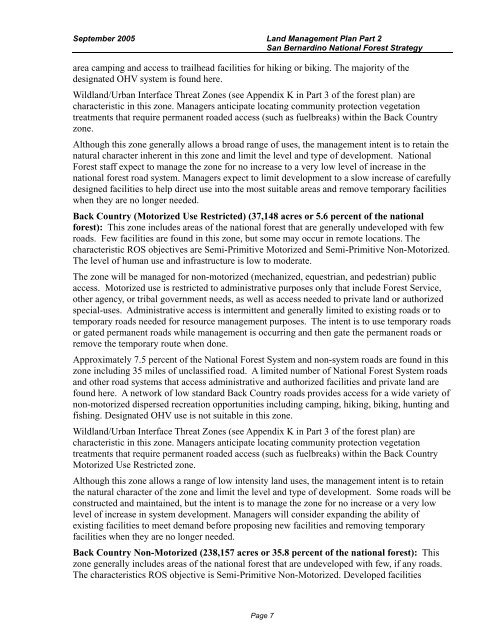San Bernardino National Forest Land Management Plan - Part 2
San Bernardino National Forest Land Management Plan - Part 2
San Bernardino National Forest Land Management Plan - Part 2
You also want an ePaper? Increase the reach of your titles
YUMPU automatically turns print PDFs into web optimized ePapers that Google loves.
September 2005 <strong>Land</strong> <strong>Management</strong> <strong>Plan</strong> <strong>Part</strong> 2<br />
<strong>San</strong> <strong>Bernardino</strong> <strong>National</strong> <strong>Forest</strong> Strategy<br />
area camping and access to trailhead facilities for hiking or biking. The majority of the<br />
designated OHV system is found here.<br />
Wildland/Urban Interface Threat Zones (see Appendix K in <strong>Part</strong> 3 of the forest plan) are<br />
characteristic in this zone. Managers anticipate locating community protection vegetation<br />
treatments that require permanent roaded access (such as fuelbreaks) within the Back Country<br />
zone.<br />
Although this zone generally allows a broad range of uses, the management intent is to retain the<br />
natural character inherent in this zone and limit the level and type of development. <strong>National</strong><br />
<strong>Forest</strong> staff expect to manage the zone for no increase to a very low level of increase in the<br />
national forest road system. Managers expect to limit development to a slow increase of carefully<br />
designed facilities to help direct use into the most suitable areas and remove temporary facilities<br />
when they are no longer needed.<br />
Back Country (Motorized Use Restricted) (37,148 acres or 5.6 percent of the national<br />
forest): This zone includes areas of the national forest that are generally undeveloped with few<br />
roads. Few facilities are found in this zone, but some may occur in remote locations. The<br />
characteristic ROS objectives are Semi-Primitive Motorized and Semi-Primitive Non-Motorized.<br />
The level of human use and infrastructure is low to moderate.<br />
The zone will be managed for non-motorized (mechanized, equestrian, and pedestrian) public<br />
access. Motorized use is restricted to administrative purposes only that include <strong>Forest</strong> Service,<br />
other agency, or tribal government needs, as well as access needed to private land or authorized<br />
special-uses. Administrative access is intermittent and generally limited to existing roads or to<br />
temporary roads needed for resource management purposes. The intent is to use temporary roads<br />
or gated permanent roads while management is occurring and then gate the permanent roads or<br />
remove the temporary route when done.<br />
Approximately 7.5 percent of the <strong>National</strong> <strong>Forest</strong> System and non-system roads are found in this<br />
zone including 35 miles of unclassified road. A limited number of <strong>National</strong> <strong>Forest</strong> System roads<br />
and other road systems that access administrative and authorized facilities and private land are<br />
found here. A network of low standard Back Country roads provides access for a wide variety of<br />
non-motorized dispersed recreation opportunities including camping, hiking, biking, hunting and<br />
fishing. Designated OHV use is not suitable in this zone.<br />
Wildland/Urban Interface Threat Zones (see Appendix K in <strong>Part</strong> 3 of the forest plan) are<br />
characteristic in this zone. Managers anticipate locating community protection vegetation<br />
treatments that require permanent roaded access (such as fuelbreaks) within the Back Country<br />
Motorized Use Restricted zone.<br />
Although this zone allows a range of low intensity land uses, the management intent is to retain<br />
the natural character of the zone and limit the level and type of development. Some roads will be<br />
constructed and maintained, but the intent is to manage the zone for no increase or a very low<br />
level of increase in system development. Managers will consider expanding the ability of<br />
existing facilities to meet demand before proposing new facilities and removing temporary<br />
facilities when they are no longer needed.<br />
Back Country Non-Motorized (238,157 acres or 35.8 percent of the national forest): This<br />
zone generally includes areas of the national forest that are undeveloped with few, if any roads.<br />
The characteristics ROS objective is Semi-Primitive Non-Motorized. Developed facilities<br />
Page 7
















